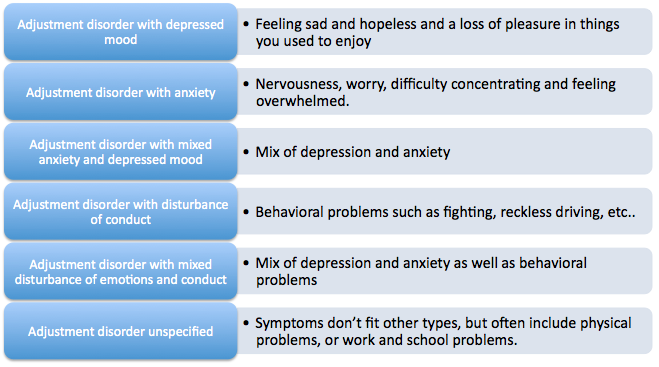An adjustment disorder (AD) is a type of stress-related mental illness that occurs when an individual is unable to normally adjust or cope with stressful changes in their lives.
What causes it?
Adjustment disorders (or situational depression) is differentiated from major depression in that it is caused by an outside stressor and is generally resolved once the individual learns to adapt to their environment.
Although the actual cause of adjustment disorders are unknown, psychologists have identified risk factors that are more often associated with AD than other Axis I disorders. These include:
- younger age
- more identified psychosocial problems
- increased suicidal behavior
- less frequent previous psychiatric history
- shorter length of treatment
- more exposure to trauma
Among children and teenagers, both boys and girls have the same chance of having adjustment issues. However, among adults, women are twice as likely to develop adjustment disorders.
What are the signs?
There are six different types of adjustment disorders listen in the DSM-IV-TR. They are characterized by the following predominant symptoms:
- depressed mood
- anxiety
- mixed depression and anxiety
- disturbance of conduct
- mixed disturbance of emotions and conduct
The criteria to diagnose someone with AD include that (1) the symptoms must clearly follow a stressor, (2) symptoms should be more severe than would be expected, (3) no underlying disorders, and (4) symptoms present are not part of a normal grieving process.
Adjustment disorders are also classified as either acute or chronic:¹
6 months or less (acute) - In these cases, symptoms may go away on their own, especially if the individual actively follow self-care measures.
More than 6 months (chronic) - In these cases, symptoms will most likely continue to disrupt the individual’s life without professional treatment.
How is AD treated?
Most often, the treatment for AD is psychotherapy (also known as counselling or talk therapy).This therapy can consist of group therapy, individual therapy or family therapy. This helps establish a support system and learning healthy coping skills. In some cases, medication may be prescribed to help combat symptoms of depression and anxiety.
References:
1. Mayo Clinic Staff (2011). Adjustment Disorders - Tests and Diagnosis. [ONLINE] Available at: http://www.mayoclinic.com/health/adjustment-disorders/DS00584/DSECTION=tests-and-diagnosis. [Last Accessed 5.12.2013].
